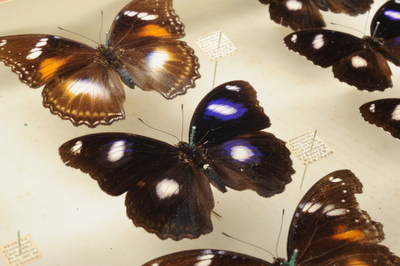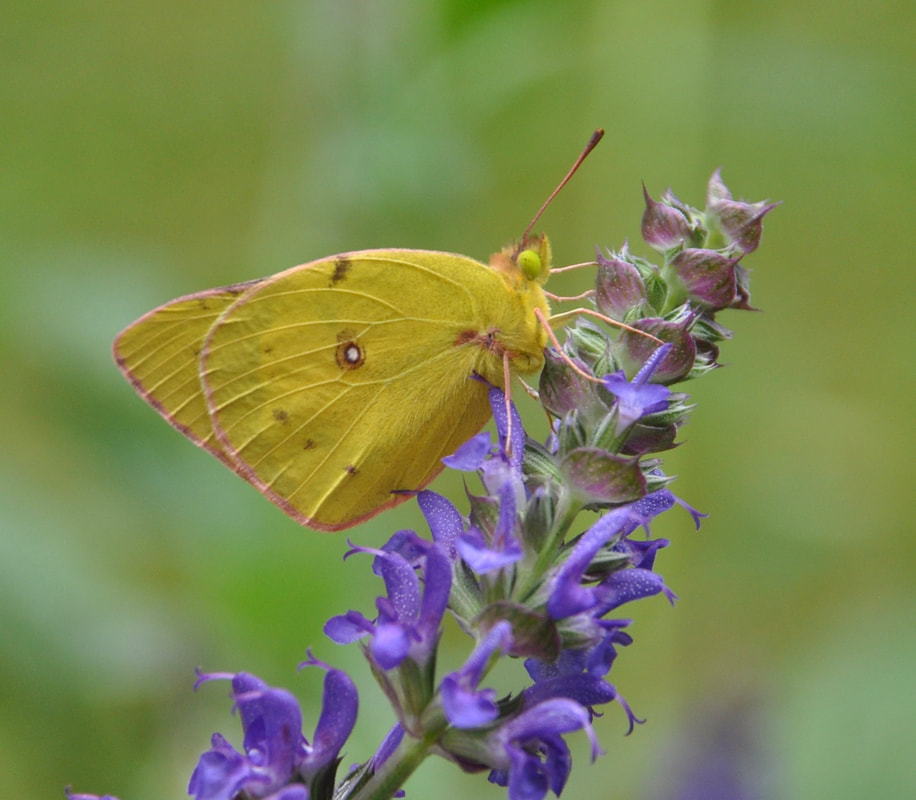Dr Emily Hornett PhD
Research Associate Evolution, Ecology & Behaviour
- +44 (0)151 795 4528
- Work email Emily.Hornett@liverpool.ac.uk
- About
- Research
- Publications
- Professional Activities
Research
The interaction between insects and bacteria that alter host reproduction 1. The tale of a tropical butterfly and male-killing Wolbachia

Much of my early research has focused upon the Blue Moon butterfly Hypolimnas bolina. This tropical nymphalid is infected across much of its Asian to Polynesian range with the maternally inherited bacteria Wolbachia. Wolbachia has become infamous amongst researchers studying arthropods both due to its prevalence across taxa (estimates vary based on the method, but it is thought to infect up to 60% of insects), and the remarkable range of effects it imparts upon its host. These include manipulations of host reproduction: feminisation of genetic males, cytoplasmic incompatibility of uninfected female hosts with infected males, and the induction of parthogenesis. In H. bolina, Wolbachia kills the male offspring of infected females (male-killing), leading to a female-bias in the sex ratio of the brood. If the infection is at high frequency within a population (as observed in several butterfly species including this one), the population itself can be highly female-biased. Wolbachia also has other tricks, for e.g. recent research has revealed that Wolbachia can provide protection for the host against pathogens such as viruses. Therefore, as is increasingly being seen as the case for many host-associated microbes, Wolbachia can act beneficially as well as parasitically, with the outcome often depending on host or environmental context.
-> Early work led to the discovery that the H. bolina/Wolbachia interaction exhibits remarkable spatial variation in both Wolbachia frequency within and across populations, and in the phenotype expressed by this bacterium: male-killer in some populations, and no observable phenotype in others. A second strain of Wolbachia in some populations was discovered to cause Cytoplasmic Incompatibility...where infected males are incompatible (no or few surviving offspring) with uninfected females.
-> Utilising museum samples to unveil temporal dynamics
Further investigation involved successfully designing and validating methods of extracting and amplifying museum specimen DNA. Wolbachia infection prevalence, and the frequency of infected males (indicating suppressor evolution) in museum samples were compared to current samples from the same population. The results showed a substantial amount of flux in the system, both over time within populations, and throughout the range of the butterfly (Hornett et al 2009).
-> Suppression of male-killer activity
The spatial variation in action of Wolbachia is due to the host evolving suppression of male-killing phenotype in SE Asian populations (Hornett et al 2006). This was shown through introgression of nuclear genes from SEA into the butterflies from Polynesia which were infected with Wolbachia that killed males. A male with the Polynesian MK Wolbachia that also had nuclear genes from SEA survived infection. Removal of SEA nuclear genes by backcrossing to Polynesia butterflies reversed the phenotype and male-killing re-started.
This work was the first conclusive evidence that a host had suppressed the effects of a male-killing bacteria - a finding expected from theory due to the very high detrimental effects imposed by the bacteria on the host.
-> Discovery of a hidden phenotype
The question then arose of why the infection was still present at high frequency in the populations which had the suppressor? Breeding work revealed that the infected male butterflies in SE Asia were incompatible with uninfected females and produced few or no viable offspring from these matings. This reproductive manipulation, called cytoplasmic incompatibility (CI), is commonly caused by Wolbachia in other insects. Moreover, the males that survived infection in Polynesia by having SEA nuclear genes (and so the suppressor) where also found to be incompatible with uninfected females (numbers in pic are the number of hatching eggs). Thus CI here is an emergent, not an evolved trait - a finding which indicates the possibility that male-killing and CI are functionally linked somehow. This study provided the first case study where Wolbachia displayed different manipulation phenotypes within a host species (Hornett et al 2008).
-> Rapid evolution on an island
During the course of my PhD we were fortunate to witness natural selection in action. Previous work in Greg Hurst's lab had shown that in 2001 and for the preceding 100 years, the sex ratio of H. bolina in the islands of Samoa in the Pacific was at a remarkable 100 females to every one male - a phenomenon caused by the male-killing Wolbachia bacteria. By 2006 however, numerous males were suddenly observed. Our work demonstrated that host suppression of male-killing had arrived on these islands (most probably through migration of a suppressor-carrying butterfly) and spread extremely rapidly through the population (Charlat, Hornett et al 2007).
-> Impact of intense natural selection on the host genome
Following on from the discovery that this butterfly has evolved suppression of male-killing, I investigated the genetic architecture behind suppression. Using a targeted gene approach, linkage mapping and high-throughput sequencing we located the chromosome upon which the suppressor lies, and its approximate position. Then by comparing allele frequencies at markers sited across this chromosome in population samples from Samoa in 2001 (pre-suppressor spread) and 2006/7/10 (post-suppressor spread) we examined the consequence of suppressor spread for genetic variation around this locus. The rapid spread of the suppressor in Samoa due to intense selection, produced one of the broadest selective sweeps ever observed in a natural population (Hornett et al 2014).
The interaction between insects and bacteria that alter host reproduction 2. Green lacewings and male-killing Spiroplasma
Previous work by Daisuke Kageyama and colleagues identified a male-killing Spiroplasma in the green lacewing Mallada desjardinsi. Similarly to that observed in Hypolimnas bolina (see above research interest), they noticed that while prevalence of Spiroplasma remained constant, the male-killing phenotype disappeared from the study populations in Japan and males were now common (and infected). Breeding work established the presence of a host suppressor of the male-killing phenotype in this population.
In a new collaboration with Daisuke Kageyama, I (with Greg Hurst, UoL) am seeking to identify the locus of the host suppressor, and determine with breadth of the selective sweep associated with its evolution. As part of this I am sequencing the genome of the lacewing and of the Spiroplasma.
The interaction between insects, their bacterial microbiome and the environment

I am investigating the microbiome as a factor influencing insect biology and adaptation. I am particularly interested in the tripartite interaction between the host, its microbiome and temperature.
Current areas of research include:
Understanding the influence of temperature on the microbiome of an important mosquito disease vector
Examining the contributing factors underlying microbiome composition & diversity in adult and larval Papilio butterflies
Microbiome biogeography of Colias butterflies
Research Collaborations
Daisuke Kageyama, Greg Hurst
Project: Genetics and evolutionary dynamics of male-killer suppression in the lacewing, Mallada desjardinsi
External: NARO - Institute of Agrobiological Science
We aim to identify and understand the genetic basis of host suppression of male-killing in this lacewing-Spiroplasma interaction
Ailsa McLean
Project: Male-killing symbiosis across a predator-prey interaction: a genomic and experimental approach
External: University of Oxford
This study investigates the genomic basis of male-killing in aphid-Spiroplasma interactions.
Ary Hoffmann
Project: Characterising the bacterial microbiome of Drosophila along a latitudinal cline in Australia
External: University of Melbourne
Here we characterise the bacterial microbiome of Drosophila along a latitudinal cline in Australia
Chris Jiggins
Project: The genomics of wing patterning in Hypolimnas butterflies
External: University of Cambridge
In collaboration with Chris Jiggins and Anna Orteu, we are investigating the genetic basis of wing pattern variation in Hypolimnas bolina and H. missippus.
Grant Hughes
Project: The role of the bacterial microbiome in mosquitoes
External: LSTM
Investigating the role of the bacterial microbiome in mosquitoes. Projects include characterising geographical variation of the microbiome in various host species, and assessing the impact of temperature on mosquito development and microbiome composition.
Sean Ryan
Project: Investigating the bacterial microbiome of Papilio butterflies
External
Here we aim to understand the influence of host diet and species upon the composition of the bacterial microbiome in two hybridising Papilio species across the hybrid zone in the US.
Greg Hurst
Project: Assessing the effect of Wolbachia infection on the bacterial microbiome of Hypolimnas bolina
Internal
Here I am characterising the microbiome of Wolbachia-infected and uninfected Hypolimnas bolina